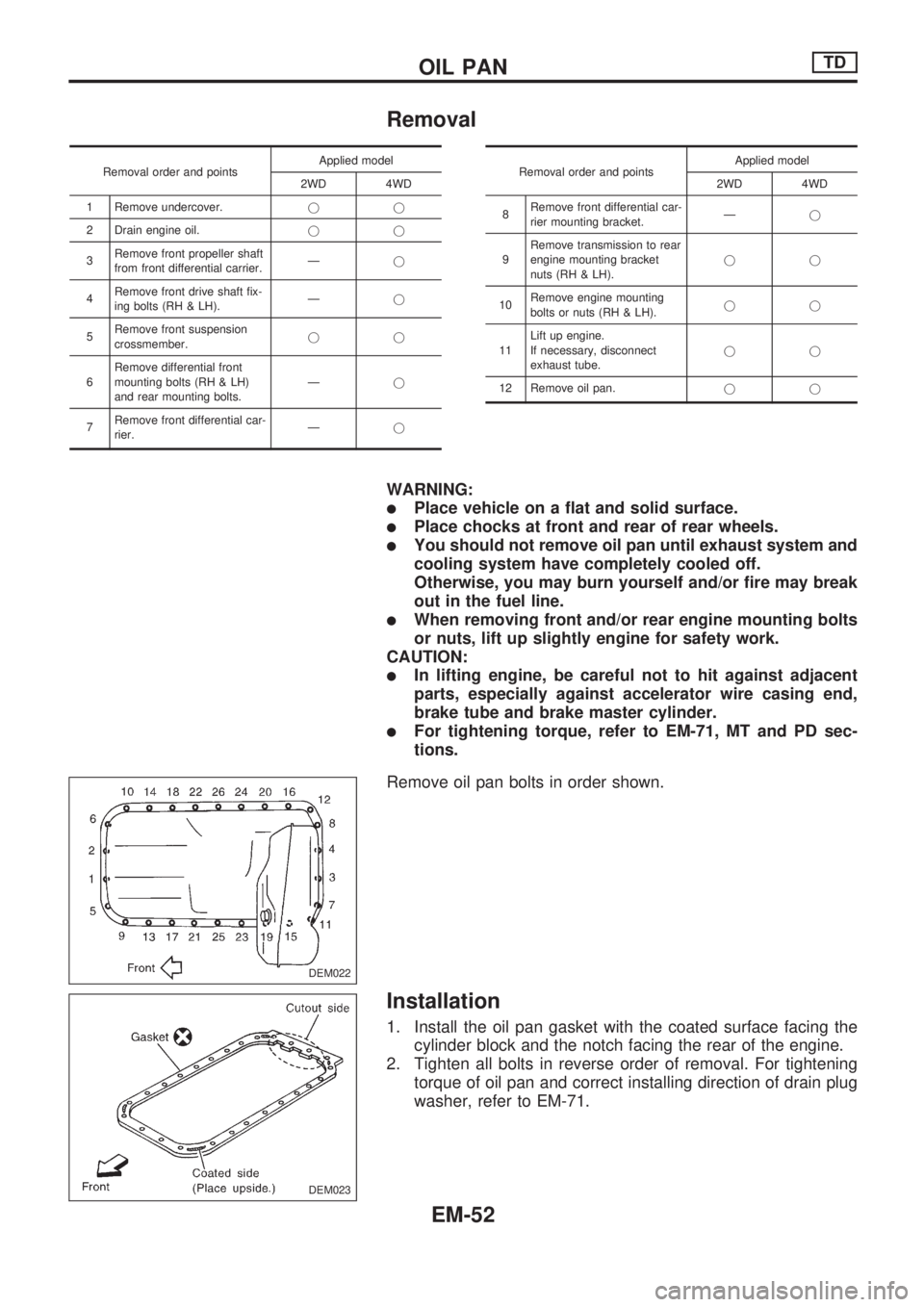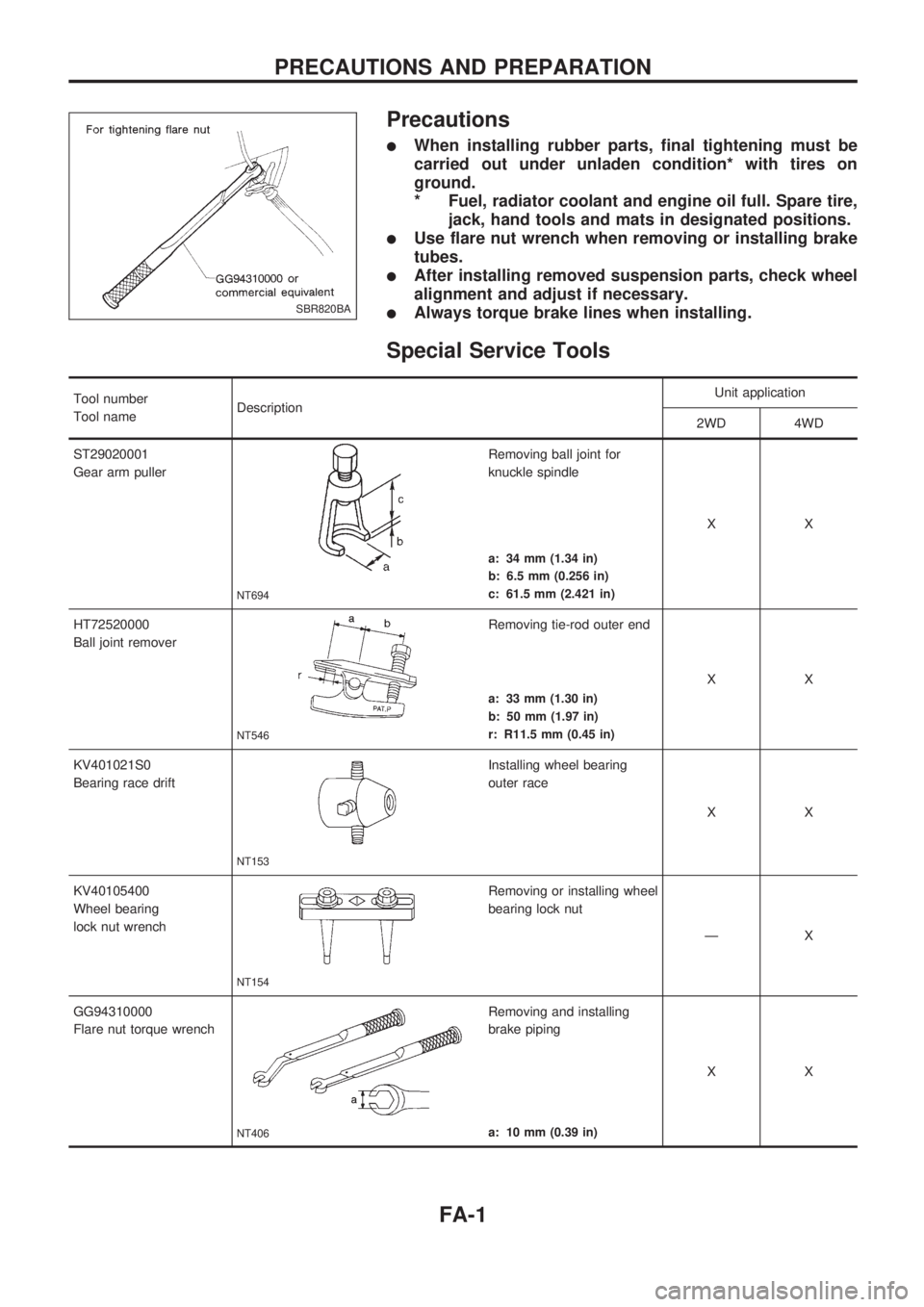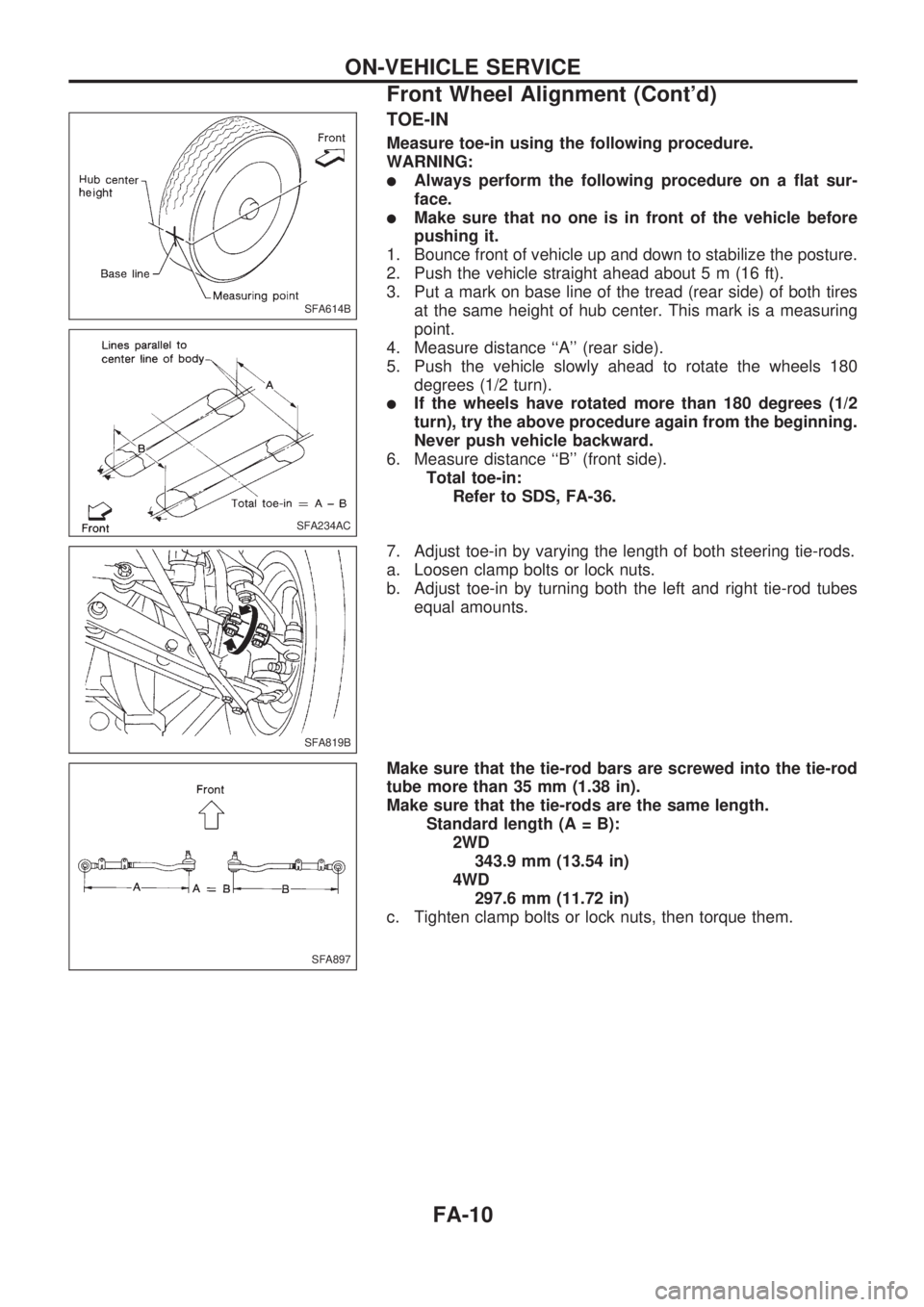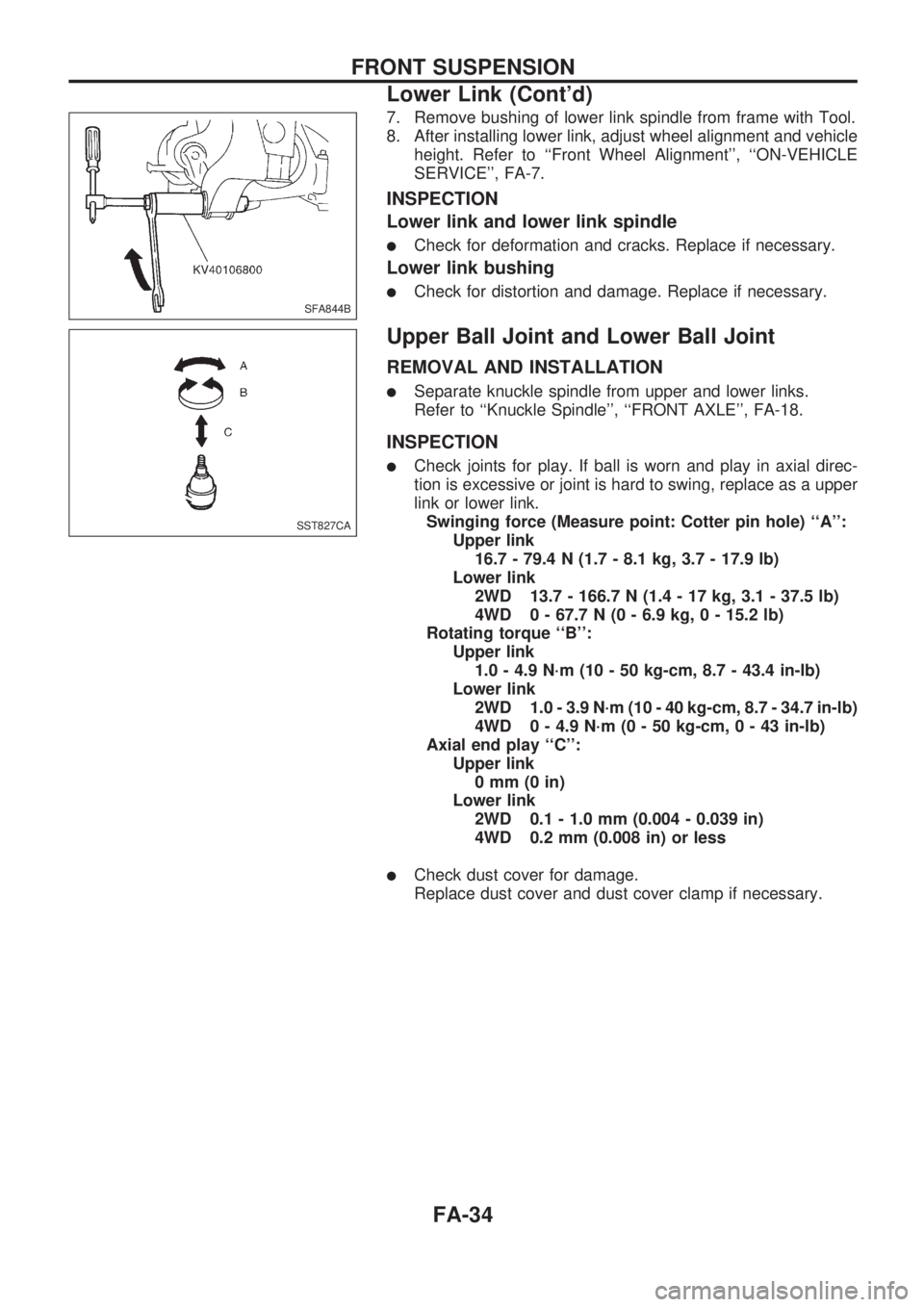1998 NISSAN PICK-UP wheel torque
[x] Cancel search: wheel torquePage 5 of 1659

Supplemental Restraint System (SRS) ``AIR
BAG'' (4WD models)
The Supplemental Restraint System ``AIR BAG'', used along with a seat belt, helps to reduce the risk or
severity of injury to the driver in a frontal collision. The Supplemental Restraint System consists of air bag
module (located in the center of the steering wheel), a diagnosis sensor unit, warning lamp, wiring harness
and spiral cable. Information necessary to service the system safely is included in theRS sectionof this
Service Manual.
WARNING:
lTo avoid rendering the SRS inoperative, which could increase the risk of personal injury or death
in the event of a collision which would result in air bag inflation, all maintenance must be per-
formed by an authorized NISSAN dealer.
lImproper maintenance, including incorrect removal and installation of the SRS, can lead to per-
sonal injury caused by unintentional activation of the system.
lDo not use electrical test equipment on any circuit related to the SRS unless instructed to in this
Service Manual. SRS wiring harnesses are covered with yellow insulation either just before the
harness connectors or for the complete harness, for easy identification.
Supplemental Restraint System (SRS) ``AIR
BAG'' (2WD models)
The Supplemental Restraint System ``AIR BAG'', used along with a seat belt, helps to reduce the risk or
severity of injury to the driver in a frontal collision. The Supplemental Restraint System consists of an air
bag module (located in the center of the steering wheel), a diagnosis sensor unit, warning lamp and spiral
cable. Information necessary to service the system safely is included in theRS sectionof this Service
Manual.
WARNING:
lTo avoid rendering the SRS inoperative, which could increase the risk of personal injury or death
in the event of a collision which would result in air bag inflation, all maintenance must be per-
formed by an authorized NISSAN dealer.
lImproper maintenance, including incorrect removal and installation of the SRS, can lead to per-
sonal injury caused by unintentional activation of the system.
lDo not use electrical test equipment on any circuit related to the SRS.
Precautions for Brake System
lUse brake fluid DOT 3 or DOT 4*1.
lNever reuse drained brake fluid.
lBe careful not to splash brake fluid on painted areas; it
may cause paint damage. If brake fluid is splashed on
painted areas, wash it away with water immediately.
lTo clean master cylinder parts, disc brake caliper parts
or wheel cylinder parts, use clean brake fluid.
lNever use mineral oils such as gasoline or kerosene.
They will ruin rubber parts of the hydraulic system.
lUse flare nut wrench when removing and installing brake
tubes.
lAlways torque brake lines when installing.
WARNING:
lClean brakes with a vacuum dust collector to minimize
the hazard of airborne materials.
*1: Refer to MA section (``Fluids and Lubricants'', ``RECOM-
MENDED FLUIDS AND LUBRICANTS'').
SBR820BA
PRECAUTIONS AND PREPARATION
BR-1
Page 697 of 1659

Removal
Removal order and pointsApplied model
2WD 4WD
1 Remove undercover.jj
2 Drain engine oil.jj
3Remove front propeller shaft
from front differential carrier.Ðj
4Remove front drive shaft fix-
ing bolts (RH & LH).Ðj
5Remove front suspension
crossmember.jj
6Remove differential front
mounting bolts (RH & LH)
and rear mounting bolts.Ðj
7Remove front differential car-
rier.ÐjRemoval order and pointsApplied model
2WD 4WD
8Remove front differential car-
rier mounting bracket.Ðj
9Remove transmission to rear
engine mounting bracket
nuts (RH & LH).jj
10Remove engine mounting
bolts or nuts (RH & LH).jj
11Lift up engine.
If necessary, disconnect
exhaust tube.jj
12 Remove oil pan.jj
WARNING:
lPlace vehicle on a flat and solid surface.
lPlace chocks at front and rear of rear wheels.
lYou should not remove oil pan until exhaust system and
cooling system have completely cooled off.
Otherwise, you may burn yourself and/or fire may break
out in the fuel line.
lWhen removing front and/or rear engine mounting bolts
or nuts, lift up slightly engine for safety work.
CAUTION:
lIn lifting engine, be careful not to hit against adjacent
parts, especially against accelerator wire casing end,
brake tube and brake master cylinder.
lFor tightening torque, refer to EM-71, MT and PD sec-
tions.
Remove oil pan bolts in order shown.
Installation
1. Install the oil pan gasket with the coated surface facing the
cylinder block and the notch facing the rear of the engine.
2. Tighten all bolts in reverse order of removal. For tightening
torque of oil pan and correct installing direction of drain plug
washer, refer to EM-71.
DEM022
DEM023
OIL PANTD
EM-52
Page 766 of 1659

Precautions
lWhen installing rubber parts, final tightening must be
carried out under unladen condition* with tires on
ground.
* Fuel, radiator coolant and engine oil full. Spare tire,
jack, hand tools and mats in designated positions.
lUse flare nut wrench when removing or installing brake
tubes.
lAfter installing removed suspension parts, check wheel
alignment and adjust if necessary.
lAlways torque brake lines when installing.
Special Service Tools
Tool number
Tool nameDescriptionUnit application
2WD 4WD
ST29020001
Gear arm puller
NT694
Removing ball joint for
knuckle spindle
XX
a: 34 mm (1.34 in)
b: 6.5 mm (0.256 in)
c: 61.5 mm (2.421 in)
HT72520000
Ball joint remover
NT546
Removing tie-rod outer end
XX
a: 33 mm (1.30 in)
b: 50 mm (1.97 in)
r: R11.5 mm (0.45 in)
KV401021S0
Bearing race drift
NT153
Installing wheel bearing
outer race
XX
KV40105400
Wheel bearing
lock nut wrench
NT154
Removing or installing wheel
bearing lock nut
ÐX
GG94310000
Flare nut torque wrench
NT406
Removing and installing
brake piping
XX
a: 10 mm (0.39 in)
SBR820BA
PRECAUTIONS AND PREPARATION
FA-1
Page 770 of 1659

Front Axle and Front Suspension Parts
Check front axle and front suspension parts for excessive play,
cracks, wear or other damage.
lShake each front wheel to check for excessive play.
If looseness is noted, adjust wheel bearing end play, then
check ball joint end play.
lMake sure that the cotter pin is inserted.
lRetighten all nuts and bolts to the specified torque.
: Refer to ``FRONT SUSPENSION'', FA-26.
lCheck front axle and front suspension parts for wear, cracks
or other damage.
lCheck shock absorber for oil leakage and other damage.
lCheck suspension ball joint for grease leakage and ball joint
dust cover for cracks and other damage.
Front Wheel Bearing
lCheck that wheel bearings operate smoothly.
lCheck axial end play.
Axial end play: 0 mm (0 in)
lAdjust wheel bearing preload if there is any axial end play or
wheel bearing does not turn smoothly.
PRELOAD ADJUSTMENT (2WD)
Adjust wheel bearing preload after wheel bearing has been
replaced or front axle has been reassembled.
1. Before adjustment, thoroughly clean all parts to prevent dirt
entry.
2. Apply multi-purpose grease sparingly to the following parts:
lRubbing surface of spindle
lContact surface between lock washer and outer wheel bear-
ing
lHub cap (as shown at left)
lGrease seal lip
3. Tighten wheel bearing lock nut to the specified torque.
: 34 - 39 N´m (3.5 - 4.0 kg-m, 25 - 29 ft-lb)
4. Turn wheel hub several times in both directions to seat wheel
bearing correctly.
5. Again tighten wheel bearing lock nut to the specified torque.
: 34 - 39 N´m (3.5 - 4.0 kg-m, 25 - 29 ft-lb)
SMA525A
SFA813B
SMA571A
SFA847B
SFA890
ON-VEHICLE SERVICE
FA-5
Page 771 of 1659

6. Turn wheel bearing lock nut back 45 degrees.
7. Fit adjusting cap and new cotter pin. Align cotter pin slot by
loosening nut 15 degrees or less.
8. Measure wheel bearing preload and axial end play.
Axial end play: 0 mm (0 in)
Wheel bearing preload
(As measured at wheel hub bolt):
New grease seal
9.8 - 28.4 N (1.0 - 2.9 kg, 2.2 - 6.4 lb)
Used grease seal
9.8 - 23.5 N (1.0 - 2.4 kg, 2.2 - 5.3 lb)
Repeat above procedures until correct bearing preload is
obtained.
9. Spread cotter pin.
10. Install hub cap.
PRELOAD ADJUSTMENT (4WD)
Adjust wheel bearing preload after wheel bearing has been
replaced or front axle has been reassembled.
Adjust wheel bearing preload as follows:
1. Before adjustment, thoroughly clean all parts to prevent dirt
entry.
2. Apply multi-purpose grease sparingly to the following parts:
lThreaded portion of spindle
lContact surface between wheel bearing washer and outer
wheel bearing
lGrease seal lip
lWheel hub (as shown at left)
3. Tighten wheel bearing lock nut with Tool.
: 78 - 98 N´m (8 - 10 kg-m, 58 - 72 ft-lb)
4. Turn wheel hub several times in both directions.
5. Loosen wheel bearing lock nut so that torque becomes 0 N´m
(0 kg-m, 0 ft-lb).
6. Retighten wheel bearing lock nut with Tool.
: 0.5 - 1.5 N´m (0.05 - 0.15 kg-m, 4.3 - 13.0 in-lb)
SFA452B
SMA574A
SRA417
SFA891
SFA814B
ON-VEHICLE SERVICE
Front Wheel Bearing (Cont'd)
FA-6
Page 775 of 1659

TOE-IN
Measure toe-in using the following procedure.
WARNING:
lAlways perform the following procedure on a flat sur-
face.
lMake sure that no one is in front of the vehicle before
pushing it.
1. Bounce front of vehicle up and down to stabilize the posture.
2. Push the vehicle straight ahead about 5 m (16 ft).
3. Put a mark on base line of the tread (rear side) of both tires
at the same height of hub center. This mark is a measuring
point.
4. Measure distance ``A'' (rear side).
5. Push the vehicle slowly ahead to rotate the wheels 180
degrees (1/2 turn).
lIf the wheels have rotated more than 180 degrees (1/2
turn), try the above procedure again from the beginning.
Never push vehicle backward.
6. Measure distance ``B'' (front side).
Total toe-in:
Refer to SDS, FA-36.
7. Adjust toe-in by varying the length of both steering tie-rods.
a. Loosen clamp bolts or lock nuts.
b. Adjust toe-in by turning both the left and right tie-rod tubes
equal amounts.
Make sure that the tie-rod bars are screwed into the tie-rod
tube more than 35 mm (1.38 in).
Make sure that the tie-rods are the same length.
Standard length (A = B):
2WD
343.9 mm (13.54 in)
4WD
297.6 mm (11.72 in)
c. Tighten clamp bolts or lock nuts, then torque them.
SFA614B
SFA234AC
SFA819B
SFA897
ON-VEHICLE SERVICE
Front Wheel Alignment (Cont'd)
FA-10
Page 799 of 1659

7. Remove bushing of lower link spindle from frame with Tool.
8. After installing lower link, adjust wheel alignment and vehicle
height. Refer to ``Front Wheel Alignment'', ``ON-VEHICLE
SERVICE'', FA-7.
INSPECTION
Lower link and lower link spindle
lCheck for deformation and cracks. Replace if necessary.
Lower link bushing
lCheck for distortion and damage. Replace if necessary.
Upper Ball Joint and Lower Ball Joint
REMOVAL AND INSTALLATION
lSeparate knuckle spindle from upper and lower links.
Refer to ``Knuckle Spindle'', ``FRONT AXLE'', FA-18.
INSPECTION
lCheck joints for play. If ball is worn and play in axial direc-
tion is excessive or joint is hard to swing, replace as a upper
link or lower link.
Swinging force (Measure point: Cotter pin hole) ``A'':
Upper link
16.7 - 79.4 N (1.7 - 8.1 kg, 3.7 - 17.9 lb)
Lower link
2WD 13.7 - 166.7 N (1.4 - 17 kg, 3.1 - 37.5 lb)
4WD 0 - 67.7 N (0 - 6.9 kg, 0 - 15.2 lb)
Rotating torque ``B'':
Upper link
1.0 - 4.9 N´m (10 - 50 kg-cm, 8.7 - 43.4 in-lb)
Lower link
2WD 1.0 - 3.9 N´m (10 - 40 kg-cm, 8.7 - 34.7 in-lb)
4WD 0 - 4.9 N´m (0 - 50 kg-cm,0-43in-lb)
Axial end play ``C'':
Upper link
0mm(0in)
Lower link
2WD 0.1 - 1.0 mm (0.004 - 0.039 in)
4WD 0.2 mm (0.008 in) or less
lCheck dust cover for damage.
Replace dust cover and dust cover clamp if necessary.
SFA844B
SST827CA
FRONT SUSPENSION
Lower Link (Cont'd)
FA-34
Page 800 of 1659

General Specifications
Suspension typeIndependent double wishbone
torsion bar spring
Shock absorber type Double-acting hydraulic
Stabilizer Standard or optional equipment
Inspection and Adjustment
WHEEL BEARING
2WD
Wheel bearing axial end play
mm (in)0 (0)
Wheel bearing lock nut
Tightening torque
N´m (kg-m, ft-lb)34-39
(3.5 - 4.0, 25 - 29)
Return angle degree 45É - 60É
Wheel bearing starting torque
At wheel hub bolt
With new grease seal
N (kg, lb)9.8 - 28.4
(1.0 - 2.9, 2.2 - 6.4)
With used grease seal
N (kg, lb)9.8 - 23.5
(1.0 - 2.4, 2.2 - 5.3)
4WD
Wheel bearing lock nut
Tightening torque
N´m (kg-m, ft-lb)78-98
(8 - 10, 58 - 72)
Retightening torque after loosen-
ing wheel bearing lock nut
N´m (kg-m, ft-lb)0.5 - 1.5
(0.05 - 0.15, 0.4 - 1.1)
Axial end play mm (in) 0 (0)
Starting force at wheel hub bolt
N (kg, lb)A
Turning angle degree 15É - 30É
Starting force at wheel hub bolt
N (kg, lb)B
Wheel bearing preload at wheel hub
bolt N (kg, lb)
BþA7.06 - 20.99
(0.72 - 2.14, 1.59 - 4.72)
WHEEL RUNOUT AVERAGE*
Wheel typeSteel
5J-14 5.5K-15 6J-16
Radial runout limit
mm (in)0.5
(0.020)0.8
(0.031)1.2
(0.047)
Lateral runout limit
mm (in)0.8
(0.031)0.8
(0.031)1.2
(0.047)
* Wheel runout average = (Outside runout value + Inside runout value)
x 0.5
UPPER BALL JOINT
Swinging force ``A''
(Measuring point: cotter pin hole
of ball stud)
N (kg, lb)16.7 - 79.4
(1.7 - 8.1, 3.7 - 17.9)
Turning torque ``B''
N´m (kg-cm, in-lb)1.0 - 4.9
(10 - 50, 8.7 - 43.4)
Vertical end play ``C''
mm (in)0 (0)
LOWER BALL JOINT
Applied model 2WD 4WD
Swinging force ``A''
(Measuring point: cotter pin hole
of ball stud)
N (kg, lb)13.7 - 166.7
(1.4 - 17,
3.1 - 37.5)0 - 67.7
(0 - 6.9,
0 - 15.2)
Turning torque ``B''
N´m (kg-cm, in-lb)1.0 - 3.9
(10 - 40,
8.7 - 34.7)0 - 4.9
(0 - 50, 0 - 43)
Vertical end play ``C''
mm (in)0.1 - 1.0
(0.004 - 0.039)0.2 (0.008 in)
or less
SERVICE DATA AND SPECIFICATIONS (SDS)
FA-35